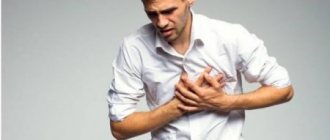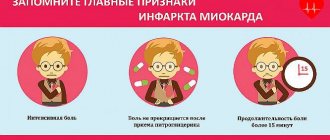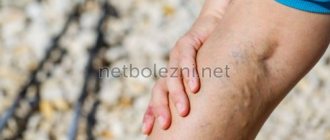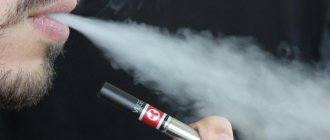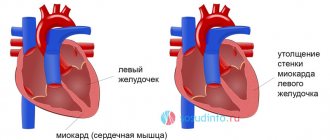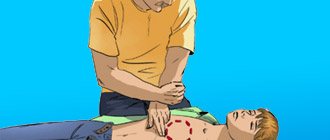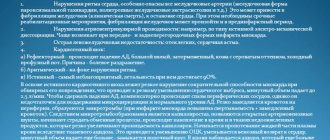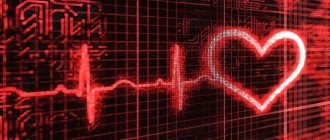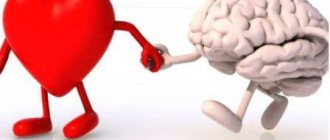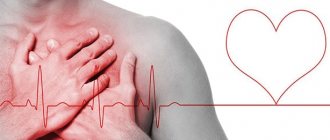What is a heart attack and where does it come from?
Myocardial infarction is necrosis (death) of heart tissue.
It appears Heart attack - Symptoms and cause, when for some reason blood stops flowing to the heart muscle (myocardium). Due to lack of oxygen, parts of the heart begin to die. The most common cause is a narrowing of the arteries supplying the heart, for example, due to cholesterol plaques. This condition is called coronary heart disease. For coronary artery disease to transform into a heart attack, sometimes no provoking factors are needed: it is enough to wake up and get out of bed for the plaque to rupture and the resulting blood clot to block the blood vessel. With stress or unusual physical activity, this risk increases.
Another, albeit less common, cause is a sudden spasm of the Heart attack of the coronary artery, which stops blood flow to the heart muscle.
What benefits are available after a heart attack?
Myocardial infarction is a dangerous form of heart disease, which, unfortunately, is becoming more common in people of all ages.
After a heart attack, a person needs long-term treatment and rehabilitation, which can be fully achieved only with the help of additional social support measures.
What additional benefits can a person count on after suffering a myocardial infarction?
1) Paid sick leave
(if the patient works under an employment contract) for a long period - up to 10 months (with periodic commission extensions) or up to 12 months (if an operation was performed).
2) Receive free medicines
necessary for the treatment of the disease, in accordance with the doctor’s prescription - during the first 6 months after the heart attack.
3) Referral for free follow-up treatment to a domestic sanatorium-resort institution
(balneological or climatic type) for up to 24 days. Vouchers are issued by medical institutions where people who have had a heart attack are treated, and they are paid for by the Social Insurance Fund.
A ticket to a sanatorium is issued on the condition that the patient has suffered an acute myocardial infarction, has no medical contraindications for sanatorium treatment, is physically active to a sufficient extent, can independently move up to 1.5 km and climb up the stairs 1 – 2 flights without pain.
4) Restrictions on work activity
. The following types of work are contraindicated for persons who have suffered a myocardial infarction:
– associated with an increased degree of danger (work as a driver, pilot, airport dispatcher, railway transport, etc.), maintenance of electrical devices,
– involving active movement (work as a courier, postman, salesman, etc.),
– work outside the populated area, in the field, in the open air (work as a builder, geologist, etc.) or in an unfavorable climate (in the northern regions, for example),
– work at high altitude (installers, crane operators, etc.),
– harmful production (with effects on the body of toxic substances),
If a person who has suffered a heart attack is employed in one of the specified types of work, he is given a medical certificate about the inadmissibility of performing certain types of work and the issue of registering disability is resolved.
The employer is obliged to temporarily transfer such a person to a job that corresponds to his state of health (with his consent), or release him from work duties without preserving his earnings for the period until disability is established, but not more than for 4 months.
If after this the employer does not have jobs that meet the medical indications for the employee, he is fired.
5) Determination of disability
. Depending on a person’s state of health and his ability to self-care, the attending physician may decide to refer him for a medical and social examination (MSE) to establish disability.
ITU institutions conduct an examination of the citizen and, guided by the criteria of the Ministry of Health, determine whether he has signs of disability.
If a citizen has a moderate disorder of the functions of the circulatory system and has difficulties performing usual work, he is assigned disability group 3.
With higher degrees of impairment of body functions and the ability to self-care, they may be assigned group 2 or 1.
When you need to urgently call an ambulance
At the slightest suspicion of a heart attack, you should immediately call 103 or 112 or go to the nearest emergency department. If it is truly a heart attack, help should be provided within a maximum of 1-2 hours. Heart Attack: Symptoms, Causes, Treatment, and Prevention. Otherwise, the consequences of a heart attack may become irreversible, and the risk of death will increase significantly.
Therefore, it is important to know what the symptoms of a heart attack look like.
- Severe pain behind the sternum, which increases gradually and sometimes spreads to the left arm, shoulder, jaw, neck, under the left shoulder blade. The pain can be different: it presses behind the sternum, burns, bursts. This is the most common sign.
- Panic fear, which often comes along with pain. The man is worried, clutching his heart.
- Feeling of shortness of breath, like an asthma attack. Moreover, if a person is asthmatic and quickly takes a drug that makes breathing easier, it does not become easier for him.
- Shortness of breath despite no physical activity.
- Weakness, sudden dizziness, clouding of consciousness.
- Rapid, uneven heartbeat Heart Attack: Symptoms, Causes, Treatment, and Prevention.
- Cold sweat.
- Nausea, heartburn, abdominal pain.
Signs of a heart attack can be different: some people have many of them and they are pronounced. Others, on the other hand, experience only minor chest pain and weakness. But the more symptoms you have, the higher the risk that it is actually a heart attack.
Symptoms of a drug-induced heart attack
Like any form of heart attack, the disease provoked by drugs is accompanied by pain. However, they are most often projected not in the region of the heart, but radiate down and closer to the back. In addition to pain, there is:
- fear of imminent death;
- stiffness of movements;
- nausea and vomiting (in rare cases);
- profuse sweating.
To relieve pain, it is recommended to take nitroglycerin, which you should always keep with you and call an ambulance.
What to do before the ambulance arrives if someone else has a heart attack
- Lay the victim down. The position should be semi-sitting.
- Loosen your clothes if they are making it difficult to breathe.
- Open a window or otherwise provide fresh air.
- Give the victim nitroglycerin if previously prescribed by a doctor. Follow the instructions strictly.
- Give aspirin. Firstly, it relieves pain. Secondly, the drug thins the blood. This improves blood flow and may provide relief. Please note that aspirin should not be taken Chest Pain: First Aid if you are allergic to it or suffer from diseases associated with low blood clotting.
- Do everything to calm the person down.
- Tell the visiting doctors when the attack began, what symptoms were associated with it, and whether you took pills - which ones and in what quantity.
Providing emergency care for myocardial infarction
The patient can put a nitroglycerin tablet under the tongue and immediately call an ambulance. Intensive therapy will be carried out in the intensive care unit. As a rule, in case of myocardial infarction, thrombolytic agents, analgesics, anticoagulants, and beta-blockers are prescribed. Untimely treatment for myocardial infarction can lead to death.
Myocardial infarction is an emergency condition that occurs due to an acute disruption of the blood supply to the heart muscle. This condition is directly life-threatening, and therefore requires emergency measures to be taken in the acute period, as well as adequate treatment after it has been suffered.
How to reduce the risk of a heart attack, including a recurrent one
Heart attacks are more common in men over 45 and women over 55. Those who have already had a heart attack in their family are also at risk. Unfortunately, it is impossible to combat these risk factors. But there are others that are entirely within your power to defeat.
Here's what to do to reduce your chance of having a heart attack.
- Try to quit smoking and give up alcohol.
- Move more. According to 5 Heart Facts That May Surprise You from Johns Hopkins University experts, physical inactivity is even more dangerous than smoking.
- Spend as little time as possible sitting. A sedentary lifestyle is another powerful risk factor.
- Watch your blood pressure. High blood pressure can damage the arteries that supply the heart. If you experience attacks of hypertension, be sure to consult with a therapist or cardiologist and learn how to return your blood pressure to normal.
- Control your cholesterol levels.
- Watch your weight. Try not to lead the situation to obesity.
- Learn to deal with stress.
Yes, these are boring prevention recipes. But others don’t work, and there is no magic pill for a heart attack. Everything is in your hands, and this also applies to your heart.
How to distinguish a heart attack from angina pectoris
The problem is relevant even for cardiologists. It is impossible to carry out differential diagnosis on your own. Both processes are determined only approximately.
Specific signs of necrosis of cardiac structures:
- Acute pain. The discomfort is extremely intense. It radiates to the shoulder blade, back in general, neck, jaw, forearm, moves all the way to the hand. The force is so great that the patient may lose consciousness.
There is also a more insidious option. When the discomfort is moderate or mild, but obsessive, lasts more than half an hour. You need to remember: with angina, the pain is always pronounced, but not unbearable, lasting up to 30 minutes maximum.
In any case, the first action when persistent heart pain is detected should be to call an ambulance. You won’t be able to delimit states on your own.
- There is an effect of Nitroglycerin. But against the background of myocardial infarction it is incomplete, partial. The discomfort subsides, but does not go away. An attack of coronary insufficiency responds better to medications, so stable correction of the patient’s condition is possible. You need to listen carefully to how you feel.
- Severe arrhythmia. It occurs more often with necrosis of the heart muscle. Accompanied by typical disorders: freezing in the chest, turning over, tying a knot, missing blows. These are non-specific moments, so it is impossible to say exactly what caused it.
- Fainting conditions. Against the background of a heart attack, they are also more common.
- Severe shortness of breath. Inability to take in air, problems with the natural process. Panic and a feeling of fear are growing.
- Increased sweating. Almost never occurs during an attack. Against the background of necrosis, much more often. Speaks of a sharp drop in blood pressure and weakening of cardiac activity.
- Rate of progression. A heart attack is more aggressive and leads to health problems faster. In the fairer sex, it develops gradually, which is different from an attack of coronary insufficiency. In female patients, detection of pathology is easier.
In general, it is impossible to distinguish a heart attack from angina without special methods. And such differentiation is not of great importance at the prehospital stage.
In about 15% of emergency cases, there are no symptoms at all. The group at increased risk of developing a “silent” heart attack includes people over 50 years of age, patients with diabetes mellitus and arterial hypertension.
Only in hospital
Acute coronary syndrome is a collective concept that includes unstable angina and acute myocardial infarction. The treatment strategy for this condition is to quickly restore blood flow, which saves the myocardium and the life of the patient. And such assistance can only be provided in a hospital or vascular center, provided that the patient is delivered within two hours from the moment the vessel is blocked. Statistics confirm this: mortality in hospitals from myocardial infarction is 13–14%, in vascular centers – even lower.
Correct routing of patients and stenting are a real opportunity to reduce mortality from heart attacks, Maria Glezer emphasized. According to her, the introduction of a system of vascular centers made it possible to reduce hospital mortality from acute heart attack in the Moscow region by 60% - an impressive figure. But the problem is that people don't call an ambulance. 40–50% of patients die at home, Maria Glezer laments: “When I ask why they were sitting at home, they answer: they thought it would go away on its own, it would resolve.” So one of the main tasks is the education of the population.
Repeated myocardial infarction is a real threat. It ranges from 10 to 20%. It is very important for people who have suffered it to be told about secondary prevention measures that can prevent rhythm disturbances and the development of such a serious pathology as heart failure, which often leads to death, says Professor Glezer.
“If the patient is lucky and survives the first time, he will not necessarily survive the second or third time,” warns the deputy director for scientific work of the medical research and educational center of Moscow State University. Lomonosov, member of the Presidium of the Russian Cardiological Society, corresponding member of the Russian Academy of Sciences, Professor Simon Matskeplishvili . “But, unfortunately, it very often happens that doctors did everything in their power to save the patient’s life: they performed primary coronary intervention, placed a stent and eliminated the cause of acute coronary syndrome or treated it conservatively. And upon discharge, they gave instructions that were designed to preserve the life and health of the patient. But, after being discharged from the hospital, he goes to the clinic, where his treatment is completely changed.”
It often happens that patients take their own medications off, and instead of really effective drugs prescribed in the hospital, they ask the doctor at the clinic to prescribe drugs from a very limited list of subsidized medications. Or worse, they switch to dietary supplements.
Heart attack is inherited. Why the heart stops in young people Read more
Providing first aid for a heart attack
If you suspect a heart attack, you should immediately call an ambulance, and it is important to indicate to the operator that it is cardiac care that is required - in this case, a specialized team will be sent, having at its disposal the necessary equipment.
Further first aid measures for a heart attack are as follows:
- Lay the patient down, provide access to fresh air: open a window or vent, loosen tight clothing;
- Give a nitroglycerin tablet under the tongue. Despite the fact that during a heart attack, nitroglycerin is not able to relieve a painful attack, the drug still has a therapeutic effect. Attention! – while waiting for the ambulance to arrive, you can give no more than three nitroglycerin tablets;
- Give the victim a tablet or two of aspirin (also known as acetylsalicylic acid). Aspirin helps thin the blood, thereby improving blood supply to the heart in conditions of ischemia; in addition, it has an analgesic effect. The tablet must be chewed - this way the effect of the drug will manifest itself faster.
If the patient has lost consciousness and the pulse cannot be felt or has become thread-like, it is necessary to immediately begin resuscitation:
- Apply a short, strong blow with your fist to the sternum area, the so-called. precordial stroke. In the absence of special tools, it can act as a defibrillator and restart a stopped heart. The blow should be struck once;
- If the precordial stroke does not have the desired effect, immediately begin performing chest compressions, while simultaneously performing artificial ventilation using one of the methods - mouth-to-nose, mouth-to-mouth. This must be done before the ambulance arrives.
